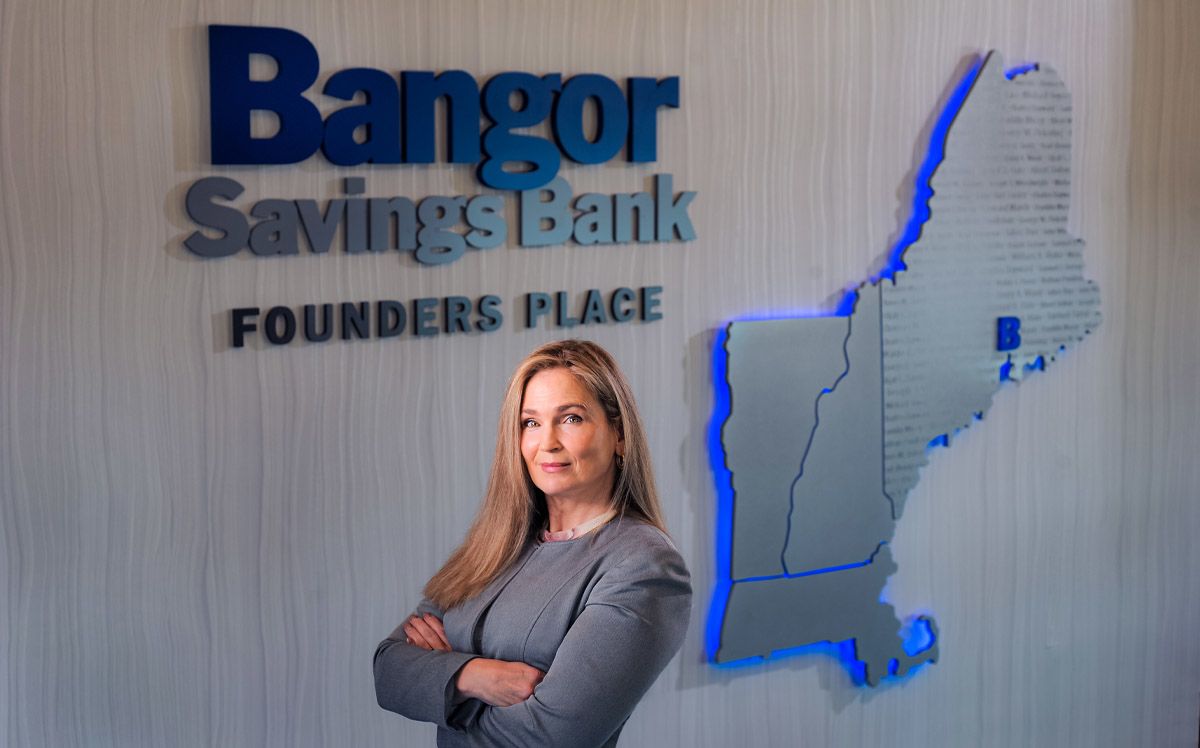
With mortgage boom waning, banks find other growth opportunities
 Photo / Fred Field
Laura Johnson, director of mortgage and consumer lending at Bangor Savings Bank, says there’s still strong buyer demand even with the higher interest rates.
Photo / Fred Field
Laura Johnson, director of mortgage and consumer lending at Bangor Savings Bank, says there’s still strong buyer demand even with the higher interest rates.
As interest rates rise and the housing frenzy of the past two years cools down, the banking industry is seeing impacts related to fewer people applying for mortgages and loss of fee and interest revenue.
But bankers say other revenue sources make up for losses and provide growth opportunities.
In late October, the Federal Home Loan Mortgage Corp. (OTCQB: FMCC), or Freddie Mac, reported the 30-year fixed-rate mortgage broke 7% for the first time since 2002 and is more than double the rate a year ago. The 15-year fixed-rate mortgage averaged 6.36%, compared with 2.37% a year ago. The five-year adjustable-rate mortgage averaged 5.96%, compared with 2.56% a year ago.
State and national Realtor associations say sales are easing, although prices continue to climb.
We asked three bankers for their take on the evolving scenario.
A shift from the ‘refi’ market
Laura Johnson is director of mortgage and consumer lending at Bangor Savings Bank.
Mainebiz: What are you seeing for mortgage activity now versus a year ago?
Laura Johnson: The housing market is slowing down. Interest rates are at the highest we’ve seen in nearly 20 years — sitting at approximately 7%. This has caused refinance application volumes to decrease 80% [nationally] from this time last year, because most borrowers already locked into a lower rate, and don’t want to refinance at a higher rate.
There is still strong buyer demand even with the higher interest rates, in part driven by increased rental rates over the past year. For instance, if you are in an apartment that saw a 10% increase in rent, it may motivate you to consider buying a home.
More recently, at Bangor Savings Bank we’ve seen an uptick in adjustable rate mortgages. Last year, ARMs were few. At the beginning of this year, ARMs were approximately 5% of our overall dollar volume. In October, they are 40% of our monthly volume and that is a 64% increase quarter-over-quarter, or 19% of our overall mortgage volume year-to-date.
However, the combined volume of our fixed and ARMs has decreased by approximately 38.5% year-to-date through September.
MB: What about home equity lines?
LJ: Generally speaking, home equity lines have seen a slight uptick in activity year-over-year. The uptick is likely caused by customers preferring not to refinance because they already have very low fixed-rate loans, so if they want money for home improvement, they could consider a home equity line of credit. Their equity has increased — nearly 40% on average — since 2020. So rather than refinancing to get cash, we’re seeing more customers explore home equity.
MB: Could you provide a comparison of average mortgage loans?
LJ: In late 2020, our mortgage low average interest was under 3% for a 30-year fixed loan, with the average loan size just under $300,000. Now, the average loan is just under $400,000 — and the rate is currently 7% or more. This activity is a reflection of the mortgage industry during these time periods.
MB: Does the higher rate deter people wanting to borrow money?
LJ: The largest impact we have seen recently has been with refinancing. This is where we are experiencing a reduction of nearly 80% year-over-year during the third quarter, where we’ve seen a reduction in closed loans. However year-to-date closed loans are only down 38.5% in terms of dollars because of the increased size of loan amounts. Fortunately, our purchase volume remains stable.
MB: How do banks make money from housing-related loans?
LJ: Banks are able to provide customers necessary financing to help them achieve their personal goals, such as home ownership. In return, Banks earn interest income for that service. To allow more customers the opportunity to finance, a secondary mortgage market exists where a portion of mortgages can be sold.
Bangor Savings Bank continues to lead a diversified approach by offering a full suite of products and services to best serve our borrowers and customers. This ensures that we maintain a sustainable, long-term approach that allows us to continue reinvesting in our customers and communities even during uncertain times.
MB: Does the bank have to adapt to accommodate reduced income?
LJ: Absolutely. As a community bank, we are always adapting to remain competitive and ensure we serve customers with our ‘You Matter More’ experience. We continue to have controls and oversight in place to manage interest rate risk and to remain responsive to the rapidly increasing rate environment. As shared, it also helps that we are diversified as we offer a full suite of products and services to meet our customers’ needs. That approach helps us to accommodate periods of potential reduced income.
MB: What are your expectations of mortgage activity going forward?
LJ: With high inflation and the climbing interest rates, we expect housing activity to continue to contract through 2023 and we expect a course correction in the market in 2024. The good news is that may lead to an increase in the housing supply, which could slow the upward trend in home prices that was largely due to a very low housing supply this year. That said, we are seeing that people today may be slower to list their homes for sale, because they’re staying put with the historically lower interest rate they secured.
Going back to pre-2019 numbers
Kim Nason is senior vice president of retail banking at Machias Savings Bank.
Mainebiz: What are you seeing for mortgage activity now versus a year ago?
Kim Nason: A significant drop in volume. Our production peaked in the mid-2021 summer and has fallen from that point. Mortgages, like the real estate industry, are cyclical. We have our highs and lows. The best way to describe it is, the minute the leaves are off the trees, people start to think less about buying homes. Once you’ve got snow, it really slows down. In the spring, activity picks up.
That said, during the pandemic years, we never saw that cycle. It was just go-go-go. All of 2021 was steady until November, when we started to see a decline.
MB: Was that decline due to rising interest rates?

KN: A couple of things were happening. The residential inventory was getting tighter, in Maine and nationally. And people were also saying, ‘Well, maybe I won’t refinance’ because of the rate increase. So our refinancing loans were going down. Maine still had good purchase volume, but people were paying cash instead of borrowing. That wasn’t because of high interest rates; it was because of heavy competition — people had a lot of excess cash and they were buying their homes that way. In the last few months, rates have started to steadily climb. Second-home buyers were the first to see the interest rate climb, because Freddie Mac and Fannie Mae were focusing on people buying primary residences.
MB: What does that mean for potential borrowers overall?
KN: Because of low inventory and higher rates, it is more difficult for first-time homebuyers to find properties and then to qualify for a loan, so that puts a strain on them. And when someone is looking at a property, they’re wondering what it’s going to cost to maintain the house. So that’s starting to factor in. More people are starting to question, ‘Do I even want to buy a house?’
MB: What’s the impact of all these puzzle pieces on the bank?
KN: Every bank needs to look at their financial model. Mortgages are volume-driven. If your volume is cut in half, your fee income is cut in half. Mortgages add to a bank’s balance sheet through the interest income. Banks have to decide whether to keep the loans on their balance sheet or sell them. If you’re keeping loans on your books, you’ll see that income flow over time. If you’re selling loans to Fannie Mae, Freddie Mac or a third-party broker that adds to the bank’s non-interest income and adds to your bottom line right away.
MB: What’s been your model?
KN: We like having a mix of residential and commercial loans on our balance sheet.
MB: What did your numbers look like in 2021 versus today?
KN: In 2021, we had $149 million in residential loans and a total of $176 million with home equity loans. That equates to 1,177 residential and home equity loans. Those were record numbers for us.
So far in 2022, we’re at about 600 loans totaling $93 million for residential and home equity loans. Those numbers go back to more normal levels seen pre-2019. That said, we’re looking to build on and expand our mortgage presence.
MB: What does the decline mean in terms of your home-loan-related income?
KN: When we have more mortgage origination, we have more fee income. From holding loans, we earn interest income based on the customer’s interest rate on the loan. With loan volumes decreasing, we anticipate earning less on our residential real estate activities until volume increases.
As a simplistic example, if we have loans on the books at 2% and we borrow it at 4%, we’re losing money on those loans. If loans are being booked for 7% today and we pay 4% for the funding cost, the bank is making money. The spread becomes relevant to the time period. If the bank’s entire balance sheet is properly managed, the margin pressure is reduced and asset liability risk is minimized.
MB: Where do banks borrow those funds?
KN: The No. 1 source of funding for most banks is its deposit base — that’s the most common source of low-cost funds. Beyond the deposit base, you can also borrow from the Federal Home Loan Bank as well as a variety of other wholesale funding sources.
MB: What are your expectations of mortgage activity going forward?
KN: Right now, we’re getting a heavy amount of home equity requests because people don’t want to lose their low-rate mortgages. It’s probably going to be a slow winter.
Mortgages still at a ‘healthy’ level
Gregory Dufour is president and CEO of Camden National Bank.
Mainebiz: What are you seeing for mortgage activity now versus a year ago?
Gregory Dufour: The mortgage industry has taken a turn as the Federal Reserve’s efforts to fight inflation have sent mortgage rates soaring. The U.S. refinancing market has declined significantly. Refinancing no longer makes sense for many homeowners, as many consumers took advantage of the unprecedented low rate environment.
In the new home purchase market, we are also seeing a significant decline, exceeding 50% to 70% off our peak activity, similar to national trends. Part of the decline is due to the comparison from the large volume purchase activity we processed over the past couple of years in the lower interest rate environment, to today’s lower activity due to higher interest rates.
That said, it is important to keep in mind that, especially for community banks, being there for homeowners, even at higher rates, is part of the full banking service we provide. Residential lending is still an important product set for us to help homeowners navigate, what can be the one of the most important purchases in their life.
MB: Does the decline result in impacts on the bank?

GD: It does. The key for us, and all Maine banks, is a diversified revenue stream. Small businesses are still an active market and have been one of our silver linings, as well as additional fee revenue sources. We are able to strategically balance our income as we look to grow and meet our customers’ needs.
MB: Camden National Bank is Maine’s No. 2 mortgage lender. What’s your outlook for that segment?
GD: We still have a strong pipeline of mortgage activity coming on, although lower than previous years. We’re confident we can maintain it at a healthy level.
MB: What are your expectations of mortgage activity going forward?
GD: We’re going through a reset for a variety of reasons as the economy absorbs the impact of rising interest rates, which also impacts home sales. Once the rate environment settles down, we’ll have a new baseline and we’ll all readjust. The last couple of years we’ve been able to invest in our technology platform and processes, to make home lending be more efficient for both us and our customers, which will help us absorb these changes.
MB: Is today’s interest rate environment ‘normal’?
GD: That’s what everyone is wrestling with. For over 10 years before the pandemic, interest rates fell and remained low. When the pandemic hit, it caused rates to go even lower, as we experienced uncharted territory. With inflation picking up as quickly as it did, some people draw analogies to the early 1980s, when inflation was significant.
Today, the Federal Reserve is trying to be proactive and curb inflation. However, other influencers, such as supply chain challenges and low unemployment, are making it challenging. There’s also geopolitical risk, which is also impacting the economy and consumer confidence. All of these things are swirling around, making it difficult to reach a new normal. We’ve gone through periods of high interest rates before, but the underlying reasons have been different, which makes it difficult to predict.
MB: Other considerations?
GD: We’ll still be helping homeowners purchase or refinance their home. That’s part of why we’re here as a community bank. I think that’s key. Camden National Bank and Maine’s banking industry in general have a long-term commitment as an economic driver for the state of Maine.














0 Comments